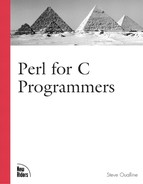Table Formatting
Many text files contain tabular data. Unfortunately, getting the columns to line up can prove difficult. For example, here is a typical file:
/dev/cdrom /mnt/cdrom iso9660 user,unhide,ro 0 0 /dev/scd1 /mnt/cdrom1 iso9660 noauto,unhide,user,ro 0 0 /dev/scd0 /mnt/cdrom2 iso9660 noauto,unhide,user,ro 0 0 /dev/loop0 /mnt/cdrom_l iso9660 noauto,unhide,user,ro 0 0 /dev/sda1 /mnt/optical ext2 defaults,noauto,user 0 0
It would be nice to see something like this:
/dev/cdrom /mnt/cdrom iso9660 user,unhide,ro 0 0 /dev/scd1 /mnt/cdrom1 iso9660 noauto,unhide,user,ro 0 0 /dev/scd0 /mnt/cdrom2 iso9660 noauto,unhide,user,ro 0 0 /dev/loop0 /mnt/cdrom_l iso9660 noauto,unhide,user,ro 0 0 /dev/sda1 /mnt/optical ext2 defaults,noauto,user 0 0
You can write a Perl program to process this text and make it look pretty. Start by reading in the data and dividing it up into words:
28 while (<>) {
29 chomp($_);
30 my @words = split /s+/, $_;
31 push (@lines, [@words]);
32 }This example uses the magic Perl file <>, which goes through all the arguments on the command line. The result is an array called @lines in which each element is a line from the input.
The actual element is not stored as a string but rather as an array of words.
Next, this data structure is processed to determine which line has the most words on it:
37 my $n_fields = 0;
38
39 foreach my $cur_line (@lines) {
40 if ($#$cur_line > $n_fields) {
41 $n_fields = $#$cur_line;
42 }
43 }Now you can go through and compute the size of each field:
48 my @field_size = ();
49 for (my $cur_field = 0;
50 $cur_field <= $n_fields;
51 $cur_field++) {
52
53 $field_size[$cur_field] = 0;
54 foreach my $cur_line (@lines) {
55 if (not defined($cur_line–>[$cur_field])) {
56 next;
57 }
58 if (length($cur_line–>[$cur_field]) >
59 $field_size[$cur_field]) {
60 $field_size[$cur_field] =
61 length($cur_line–>[$cur_field]);
62 }
63 }
64 }You’re almost there. You need to create a format string that can be used for printing the table:
69 my $format = "";
70 foreach my $cur_field (@field_size) {
71 if ($format ne "") {
72 $format .= " ";
73 }
74 $format .= "%–${cur_field}s";
75 }
76 $format .= "
";Finally, there’s nothing left to do but print it:
81 foreach my $cur_line (@lines) {
82 printf $format, @$cur_line;
83 }The result is a beautifully formatted table. The entire program is presented in Listing 16.6.
Listing 16.6. table.pl
1 =pod
2
3 =head1 NAME
4
5 table.pl – Print out tables nicely formatted
6
7 =head1 SYNOPSIS
8
9 table.pl <file> [<file> ....]
10
11 =head1 DESCRIPTION
12
13 The I<table.pl> examines the input files which are assumed to contain
14 data in columns and prints them nicely. In other words, it makes
15 the tables look nice.
16
17 =cut
18 use strict;
19 use warnings;
20
21
22 # The input as lines, then as columns
23 my @lines = ();
24
25 #
26 # Grab input, break apart into fields
27 #
28 while (<>) {
29 chomp($_);
30 my @words = split /s+/, $_;
31 push (@lines, [@words]);
32 }
33
34 #
35 # Find out how many fields there are
36 #
37 my $n_fields = 0;
38
39 foreach my $cur_line (@lines) {
40 if ($#$cur_line > $n_fields) {
41 $n_fields = $#$cur_line;
42 }
43 }
44
45 #
46 # Find the size of each field.
47 #
48 my @field_size = ();
49 for (my $cur_field = 0;
50 $cur_field <= $n_fields;
51 $cur_field++) {
52
53 $field_size[$cur_field] = 0;
54 foreach my $cur_line (@lines) {
55 if (not defined($cur_line–>[$cur_field])) {
56 next;
57 }
58 if (length($cur_line–>[$cur_field]) >
59 $field_size[$cur_field]) {
60 $field_size[$cur_field] =
61 length($cur_line–>[$cur_field]);
62 }
63 }
64 }
65
66 #
67 # Build the printing format
68 #
69 my $format = "";
70 foreach my $cur_field (@field_size) {
71 if ($format ne "") {
72 $format .= " ";
73 }
74 $format .= "%–${cur_field}s";
75 }
76 $format .= "
";
77
78 #
79 # Print
80 #
81 foreach my $cur_line (@lines) {
82 printf $format, @$cur_line;
83 }
84 |
